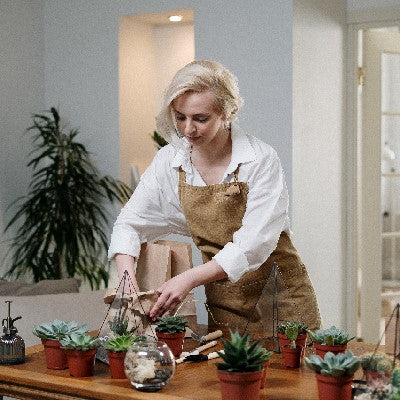Succulents are a type of plant with thick, hard leaves or wide stems that store water. Cacti are a well-known succulent type, and you might recognize them for their ability to preserve water and withstand dryness—and there are plenty of other types too. Since succulents store water, they can survive in dry conditions and drought-prone areas. These resilient green friends can endure long periods without H2O.
Plant buyers tend to love succulents because these low-maintenance plants have a reputation for being easy to care for. You do not necessarily need a green thumb to know how to keep succulents thriving. With thick, vibrant leaves and quirky flair, succulents are very attractive and add greenery to indoor spaces. Despite their reputation for being low-maintenance, caring for succulents can be tricky at times. But do not worry—we’re here to make things easier for you. We have included some important care tips that will help you grow your succulents and keep them healthy and flourishing.
Succulents for the Canadian Household
Succulents make excellent indoor houseplants for Canadian households where we have to go through winter for almost 8 months of the year (except maybe for British Columbians, this does not apply to you). For instance, snake plants—a popular succulent type—are well-suited to indoor environments since they can survive in low-light conditions. Below are some tips on caring for succulents inside your home. Follow these, and your houseplants will thank you.
The Basic Succulent Care Tips
-
Use a pot with holes for drainage.
-
Place succulents in a bright spot by a window.
-
Give appropriate water to plants.
-
Use a soil that drains well.
-
Keep the temperatures high.
Should I use fertilizer?
Fertilizers can help boost plants while they’re growing. However, fertilizer isn’t necessary if you’re using soil, since plants can get most of their needed nutrients in the soil. If you decide to use fertilizer, timing is everything. The best time of the year to start is in the spring when new growth occurs. Fertilizer can be used once a month. During the winter, you don’t have to worry about adding fertilizer, since most plants are dormant and very little growth occurs during this season.
To boost your plant’s health, you can use a water-soluble fertilizer, and dilute it based on the product’s recommendations. Homemade fertilizers are also a good option for nourishing your plant.. You can use crushed eggshells, Epsom salt, banana peels, and coffee grounds. Most of these can be conveniently found right in your kitchen pantry or fridge. Place these on top of the soil and remove them after a few days before mold starts growing.
Pruning and maintaining succulents
When your succulent plants start getting too large, you can prune them to keep them looking trim and neat. If your succulents have thorns, spines, or milky sap, wear gloves to protect your hands.
To prune succulents, carefully inspect the stems and leaves. In the overgrown areas, check whether leaf nodes allow for growth in the desired directions. Then, cut them at that point. You can save these trimmings and use them to propagate more plants. Just let them dry for a day before planting them again.
It’s also important to remove any debris, dust, and dead leaves from your succulent. This can encourage new growth and keep away bugs and critters while keeping your plant looking healthy and happy. Removing debris is easy.Just gently wipe the leaves with a damp cloth or useg a small brush to dust away impurities.
Repotting Succulents
A growing plant is a happy plant. However, if your succulent is getting too large for its pot, then it’s time to give it a new home. First, find a new pot for your plant. Terracotta pots are a good option for succulents, since they allow soil to dry faster. Glazed and plastic pots also work well.
To repot your succulent, carefully remove it from its container. Brush off excess dirt from the roots, being careful not to damage this delicate part of the plant. After adding soil to the new pot, carefully place your succulent inside. Fill the sides around the roots with more soil until you reach ¾ of an inch below the rim of the container. Then, give the plant a week to resettle before watering it in its new home. Repotting is necessary because it gives your plant new, fresh soil and also gives it more room to grow.


